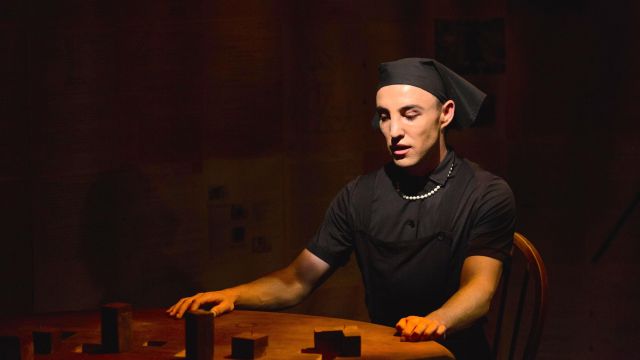I Am My Own Wife
Alone for ninety minutes on an almost bare stage, dressed in the black frock, black apron, black head scarf, heavy black shoes and a string of pearls specified in the text, Ben Gerrard is Charlotte von Mahlsdorf (born Lothar Berfelde) in this intriguing, moving, funny and mysterious play. Behind him, a near ceiling height translucent screen made up of blow-ups of Charlotte’s Stasi file: the East German Security Police’s surveillance of her, and of her betrayals of others...
Mr Gerrard is not the first to play Charlotte (there have been production all over the world since 2004, including Tasmania in 2009 ), but he is surely among the best. I don’t think the term tour de force is out of place. Aided, supported and guided by Shaun Rennie’s precise, meticulous direction, he becomes Charlotte with a flawless German accent. He peoples the stage too with over thirty other characters, switching voice, face and gesture. He becomes everything from Charlotte’s vicious Nazi father (whom Charlotte claims she killed) to her aunt, who encourages young Lothar to be a girl, to the Nazi officer who mysteriously spares a teenager in a dress, to blackmailing East German Stasi officers, to news reporters, to her best friend and fellow antiquarian Alfred, to an asinine TV chat show host - and even her playwright-biographer Doug Wright.
Yes, Mr Wright writes himself into his play. In a letter, he asks permission to meet Charlotte. He tells her that she is amazing, so amazing she should not exist: a transvestite who survived the Nazis and then the Stasi. An obvious transvestite running a cellar nightclub for East Berlin’s LGBT community under Stasi noses, and receiving an Order of Merit from the German government for her efforts as an antiquarian who maintained a museum. After Mr Wright first meets Charlotte he describes her to his friend John, adding that she wears no make-up because, she says, she ‘doesn’t need it’. That’s an example of Charlotte’s ironic humour, but she’s not averse to the attention, especially when her life experiences are an exemplar and inspiration for LGBT folk everywhere – and she’s justifiably proud of her preservation of the past with her museum.
 Lest anyone think ‘biography’ means either a plodding this-then-that narrative or some prurient, sensationalist account (given the subject matter) or, indeed, a sentimental weepie, the play is by turns chilling, charming, funny, whimsical, mischievous and enigmatic. I Am My Own Wife (also the title of Charlotte von Mahlsdorf’s autobiography – and, of course, in German the word for ‘wife’ is the same word as for ‘woman’) is not, however, a completely complete story.
Lest anyone think ‘biography’ means either a plodding this-then-that narrative or some prurient, sensationalist account (given the subject matter) or, indeed, a sentimental weepie, the play is by turns chilling, charming, funny, whimsical, mischievous and enigmatic. I Am My Own Wife (also the title of Charlotte von Mahlsdorf’s autobiography – and, of course, in German the word for ‘wife’ is the same word as for ‘woman’) is not, however, a completely complete story.
There are various lacunae and narrative leaps without explanation – which only make the work and Charlotte the more intriguing. Do we really know her – or anybody – by the end? Did she really kill her monstrous father? How, really, did she stock her museum with all those clocks and wax cylinder players? How, really, did she keep that nightclub open? There is the horrible irony that she survives the Nazis, but succumbs to the Stasi. In that there is rueful sadness and guilt and yet the realism of the survivor in her admission that, yes, she informed (as badly as she could) for them. As she asked the armchair heroes who attacked her for it afterwards, what could she do? She knew the cost of refusal – not just her life but the museum as well. But then there are neo-Nazi attacks after the Wall comes down... Truly, an amazing story of someone resolutely herself in the face of prejudice, war, fascism, prison, persecution and violence. She died in 2002, aged only 74, of a heart attack. And the title? When asked if she had gone through her life without a partner, she replied, ‘I am my own wife.’ (Or, if you like, ‘I am my own woman.’)
In addition to Mr Rennie’s direction, the other artistic elements here cohere beautifully and do nothing but enhance Charlotte’s story and Mr Gerrard’s wonderful performance. Caroline Comino’s minimalist set design is inventive and suggestive rather than fussy detailed verisimilitude. When her screen of Stasi files glows with fire the audience gives a sharp intake of breath. The effect comes from Hugh Hamilton’s lighting, which is restrained and apt throughout. Nate Edmondson’s sound design includes numerous perfectly chosen music cues and just perceptible but ominous rumbles that stir the emotions.
I’ve not seen a lot of standing ovations at 45downstairs. Mr Gerrard received one and it is thoroughly, totally merited.
Michael Brindley
Photographer: Rupert Reid
Subscribe to our E-Newsletter, buy our latest print edition or find a Performing Arts book at Book Nook.

